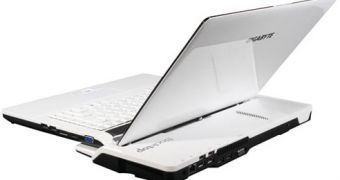The market for ultraportable computer systems continues to expand with new designs, every day, with Intel's CULV platform powering the majority of these systems. While it may seem challenging to come out with a new design for the same hardware platform, as compared with what the competition has to offer, Gigabyte looks to be up to the challenge, with its new Booktop M1305. Boasting a design similar to the company's M1022 netbook, this system adopts Intel's CULV platform in a 13.3-inch enclosure that can be paired with a desktop-docking station that further expands the portable's functionality by adding a couple of performance-driven features.
The unit itself is based on Intel's CULV chipset and processors, meaning that it can hold up to 4GB of RAM and can be fitted with a 500GB hard drive. Additional features include a 13.3-inch, 1,366 x 768 display, a replaceable optical drive, a WiFi b/g/n and Bluetooth 2.1+EDR wireless connectivity, Gigabit Ethernet, two USB 2.0 and a combo eSATA/USB port. Also featured on the new laptop, there's a VGA, audio in/out ports, a multi-in-one media card reader, a 1.3MP webcam and a fingerprint reader. According to available details, the last two features will provide a level of security to the system.
If that's not enough, the docking station further ups the ante and offers up to six USB 2.0 ports, VGA, HDMI and DVI video connectors, Gigabit Ethernet, audio in/out and an NVIDIA GeForce GT220 GPU, featuring 1GB of DDR3 memory. While the standard six-cell, 3,800mAh battery pack is claimed to be capable of delivering up to 6.5 hours of runtime, users have the possibility of replacing the optical drive with a second battery, for an added four hours of runtime.
Our colleagues at NetbookNews had the chance to spend some hands-on time with the Booktop M1305, at a Windows 7 launch party. While no details on the pricing and availability of the new, CULV-based Booktop have yet been made available, you can check out NetbookNews' hands-on video, at the end of this article.

 14 DAY TRIAL //
14 DAY TRIAL //